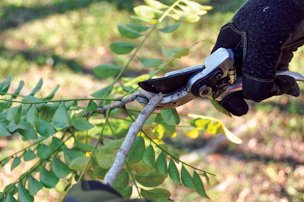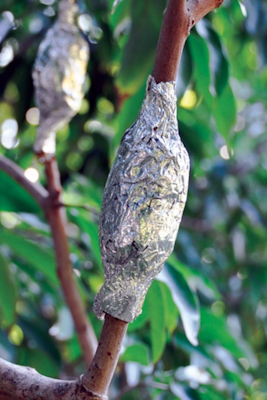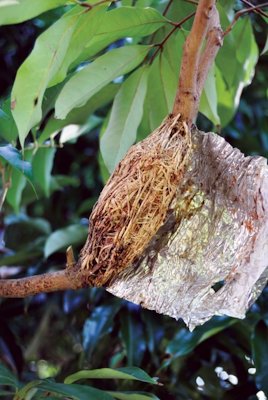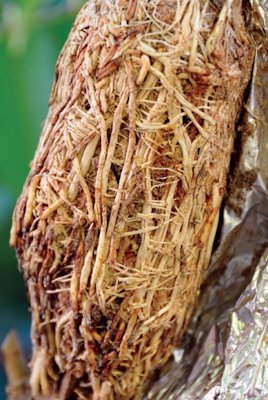Article from Edible South Florida
by Jeff Wasielewski, Extension Connection
Types of Propagation

Cutting a hog plum branch for propagation
SEED Growing plants from seed can be very easy and very cheap. You’re likely
to have two types of seeds: dry and fleshy. Dry seeds tend to float
through the air to reach their final destination and may be surrounded
by a thin papery layer to help them fly. Before planting, remove the
paper coating. Fleshy seeds are surrounded by fruit, designed to entice
an animal to move them to their final destination by eating it and
removing the fleshy covering. Remove this covering before planting.
(This is especially rewarding if you’re planting a mango seed.) Sow
seeds in well-draining, sterile soil very near the surface.
CUTTINGS Like air-layers and grafting, this results in a clone of the parent
plant. Each type of propagation doesn’t always work for every type of
plant, so you may need to experiment with different techniques to see
which one works best. Simply take a piece of the parent plant and put
it into soil to make it grow roots. You can also use a rooting hormone
at the base of the cutting to help promote root growth. Dragon fruit
(pitaya) grows easily from cuttings.
AIR-LAYERING This technique is similar to cuttings, but you don’t actually remove
the cutting from the parent plant. Remove about an inch and a half of
bark on an upright branch of the parent tree and cover that area with
moist sphagnum moss, then wrap with aluminum foil or plastic to help
retain the moisture. This area will eventually produce roots in about
six weeks or so. The new plant can then be cut from the parent tree
just below where the roots end and planted into a small container of
well-drained soil. Guavas, caimitos, Spanish limes, lychees and longans
are typically propagated by air-layering.

|  |  | Photo 1: Air-layer on a lychee tree
Photo 2: Foil is removed to reveal a fully rooted air-layer ready to be removed.
Photo 3: Fully rooted air-layer |
GRAFTING There are several different types of grafting (see link below for
detailed instructions). In each technique, you take a piece of the
parent plant, called the budwood or scion, and attach it to a healthy
seedling of the same species, called the rootstock. Mangos must be
grafted onto mangos, carambolas to carambolas, and so on. When
grafting, the thin layer between the bark and the wood, called the
cambium, must connect on the budwood and the rootstock. This will allow
the two separate plants to join and become one. The budwood of the
parent plant you wish to clone will become the top of the plant, and
the young, healthy rootstock will become the bottom of the plant. When
joining the budwood and the rootstock, tie them together to keep them
from drying out. This is generally done with thin plastic tape. Grafting is preferred for mango, jackfruit and avocado.
Whatever
technique you use, only use healthy plants to when you propagate.
Choose cuttings and budwood that are clean and free of disease. For
air-layers, choose a spot on a tree that is upright and healthy.
Usually the width of a pencil is the ideal size for cuttings,
air-layers, budwood and rootstocks.
Aftercare is crucial. Don’t
allow the propagated plant to dry out, get too wet, or bake in the sun.
A semi-shaded area for your plants to begin to grow is best. Only water
when the soil is dry. Use your finger to see if the soil is wet or dry.
For a more detailed explanation of subtropical and tropical fruit
propagation, visit edis.ifas.ufl.edu/hs1349.
Jeff Wasielewski, the commercial fruit crops extension agent for the University of Florida and Miami-Dade in Homestead...
|
|
Bibliography
Wasielewski, Jeff. "Types of Propagation." Edible South Florida, 25 Apr. 2020, ediblesouthflorida.ediblecommunities.com/things-do/types-propagation/.
Accessed 30 Apr. 2020.
Photographs
Wasielewski, Samantha C. "Types of Propagation." Edible South Florida, 25 Apr. 2020, ediblesouthflorida.ediblecommunities.com/things-do/types-propagation/.
Accessed 30 Apr. 2020.
Published 21 May 2020 LR
|



